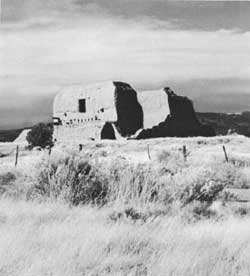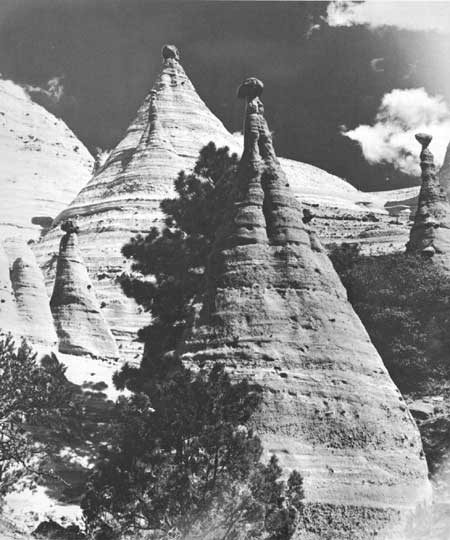.gif)
Parks for America
MENU
|
Parks for America
|

|
NEW MEXICO
NEW MEXICO embraces lofty mountain peaks and arid plains.

|
| The Pecos pueblo and mission reveal the way of life of an ancient Indian people and the faith and courage of Spanish missionaries. Now a State monument, Pecos merits inclusion in the National Park System. |
In the decade 1950-60 the State population increased 39.6 percent to 951,023, which averages 7.8 persons per square mile. However, the density ranges from less than 1 person per square mile in 2 counties to over 225 in Bernalillo County, which contains over 27 percent of the State's population. Albuquerque more than doubled its population in the decade to 201,189, making the State population 65.9 percent urban.
Tourism is the State's third largest industry, valued at more than $200 million in 1958.
The topography varies from high, forested mountains, with heavy snow cover in winter and inviting trout streams, to semidesert plains which are comfortable in winter but hot and dry in summer. Generally clear weather favors year-round outdoor recreation. Historic sites and buildings, Indian cultures, and geological phenomena are outstanding resources.
EXISTING PUBLIC AREAS
NATIONAL: The National Park Service administers 1 national park of 45,846 acres that had an attendance of 573,000 in 1960 and 9 national monuments totaling 190,716 acres with a 1960 attendance of 1,127,000. The Forest Service administers 143 recreation sites totaling 1,860 acres and 7 wilderness areas comprising 977,880 acres in 7 forests of 8,565,190 acres; also 3 land-use areas with 345,000 acres. The Bureau of Reclamation administers six reservoirs containing 97,253 acres. The Corps of Engineers administers two reservoirs of 11,081 acres. The Bureau of Sport Fisheries and Wildlife administers four national wildlife refuges containing 140,334 acres.
STATE: The State Park Commission administers nine parks totaling 6,733 acres. The 1960 attendance was 1,157,000. The State Game and Fish Department operates 31 wildlife refuges including 4 major recreation areas totaling 103,940 acres. The New Mexico State Museum administers seven monuments amounting to 758 acres and including Pecos Mission, a proposed national monument. The State Highway Department administers 240 waysides.
LOCAL: There are two local parks of 9,260 acres and three local recreation areas of 1,312 acres.
QUASI-PUBLIC: There are seven major quasi-public recreation areas totaling 129,658 acres of land and water.
PRIVATE ENTERPRISE: Private enterprise plays an important role in offering many services, concessions, and facilities throughout the State on both private and public lands.

|
| Skiers enjoy an unusual snowfall in the Jemez Crater, New Mexico, proposed as Valle Grande National Park. (WILLIAM H. REGAN, LOS ALAMOS SCIENTIFIC LABORATORY.) |
PARK AND RELATED NEEDS
The forecast of seven metropolitan areas by 1976 indicates need for immediate action by the State and by local communities to acquire known potential areas and program their future development. The existing need for more recreation opportunities in the Albuquerque area is compounded by out-of-state tourist travel. The metropolitan area of El Paso relies heavily upon New Mexico's recreation resources and facilities. A program to provide scenic routes and waysides for pleasure driving is needed. There is a definite need to protect and make available to the public areas of historic, archeologic, and geologic value. There is need for the establishment of riding and hiking trails through mountain ranges and along major rivers.
Existing State areas provide 177,842 acres for the nearly 1 million residents, and local areas provide an additional 10,572 acres. Potential areas identified in this plan total 511,243 acres considered of State significance and 2,675 acres of local. If all of these potential areas were acquired and developed, they still could not be expected to satisfy the anticipated needs of the residents by 1976.

|
| The grotesque Tent Rocks in northern New Mexico, deposits of volcanic ash eroded into weird formations, would make a significant State park. (NEW MEXICO DEPARTMENT OF DEVELOPMENT.) |
RECOMMENDATIONS
Existing recreation resources and many potential areas are shown on the accompanying tabulation and map. The following recommendations are made to help provide needed outdoor recreation opportunities for public enjoyment and use.
NATIONAL: Establishment of Valle Grande National Park (Jemez Crater) and Pecos National Monument, and study of the desirability of establishing Manuelito National Monument.
STATE: Expansion of operations of appropriate State agencies to preserve natural, scientific, and historic resources, and to provide for more recreation opportunities. Recommended are 18 parks, 44 recreation areas, 1 nature preserve, and 20 historic sites. Suggested for further study are two scientific monuments, three nature preserves, and one wilderness area.
Designation and provision of a system of scenic roads. Recommended are 68 sections of 59 routes.
Further study and investigation to establish cross-country hiking and riding trails through the more remote areas of the State.
Preservation of portions of the Rio Grande, Canadian, and Gila Rivers as free-flowing streams and consideration of this status for portions of the Pecos River.
LOCAL: Establishment of additional recreation areas to meet local needs. Nine areas are recommended.
Supporting recommendations include—
1. Improvement of existing waysides and provision of additional waysides to meet tourist and resident pleasure-driving needs.
2. Provision of more public recreation lands at important reservoirs.
3. Increased acreages of existing areas wherever feasible, especially in the Albuquerque area.
(Table omitted from online edition)

|
| (click on image for an enlargement in a new window) |
NEXT >>>
|
|
Last Modified: Mon, Sep 6 2004 10:00:00 pm PDT
parks_america/new_mexico.htm
 Top
Top